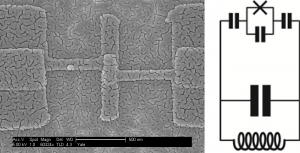Home » Uncategorized
Category Archives: Uncategorized
Variable TC Hot-Electron Mixers
I. Siddiqi
Superconducting hot-electron bolometers used in astronomy for heterodyne detection at THz frequencies are currently limited in sensitivity by fluctuations in electron temperature. A reduction in critical temperature (TC) increases sensitivity but also increases the susceptibility to saturation from background photons. Using various superconductors, we have verified the reduction in thermal fluctuation noise achieved by lowering TC, and have characterized the different saturation effects which limit mixer sensitivity. Using a bilayer material system (Nb-Au) which uses the superconductor-normal metal proximity effect to tune TC, we have demonstrated devices which should achieve an optimum balance between sensitivity and saturation.
Join us
Explore the world of mesoscopic electronics!
We’re always seeking talented and motivated students and postdocs. If you are interested in becoming a Qlab researcher, please contact Prof. Michel Devoret or any of our group members directly. Students interested in Ph.D. research can apply to either the Physics or Applied Physics graduate program (see links page)
-
- Email Address
- <first name>.<last name>@yale.edu
Address for Visitors and Shipping
Mailing Address
-
- Yale University, Applied Physics
PO Box 208284
New Haven, CT 06520-8284
- Yale University, Applied Physics
Transportation Information for Visitors
Devices
Our research aims to observe and harness novel quantum mechanical effects (quantum error correction and stabilization of quantums states by feedback, for instance) through the design, fabrication, and microwave measurement of the following superconducting electrical circuit devices:
3D Transmon Qubit
This device consists of a small Josephson junction connected to a microwave antenna in the middle of a 3D cavity resonator. The 3D Transmon is an artificial atom behaving as a slightly anharmonic oscillator. Its long coherence time and simple fabrication makes it a popular superconducting qubit.


Fluxonium Qubit
This other superconducting artificial atom used in the group has a richer level structure than the transmon, but contains of order 100 Josephson junctions. It relies on an array of large Josephson junctions behaving as a superinductance, i.e. superconducting inductance whose impedance is larger than the resistance quantum. The superinductance shunts a small junction, preventing the deleterious effect of charge offsets, yet allowing quantum phase fluctuations to express themselves. The relaxation time of the fluxonium is even larger than that of the transmon due to the particular nature of its energy eigenfunctions.


Josephson Parametric Converter (JPC)
This device is based on the Josephson Ring Modulator which is a loop of four Josephson junctions threaded by an external flux. The four nodes between junctions are connected to four quarter wave transmission lines. The JPC is used in our group as a quantum limited phase-preserving amplifier, i.e. an amplifier working essentially as an op-amp for microwave signals. We use it as a pre-amplifier in the readout chain of superconducting qubits.


Josephson Bifurcation Amplifier (JBA)
This device is based on a DC SQUID ring consisting of two Josephson junctions in parallel threaded by an external flux. The junctions are shunted by an external capacitance determining the resonant frequency of the device. The JBA is used in our group as a quantum limited phase-sensitive amplifier, i.e. an amplifier that increases one quadrature of the signal at the expense of the other quadrature. We use it as an eraser of quantum information for preparing particular quantum states.


Qlab
Welcome to Quantronics Laboratory!
Quantronics Laboratory (Qlab) explores the world of mesoscopic electronics. Our present focus is on quantum superconducting tunnel junction circuits and their applications to information processing. In these systems, macroscopic collective degrees of freedom like currents and voltages behave quantum-mechanically. Our experimental techniques combine nanofabrication, dilution refrigeration and ultra-low-noise microwave measurements.
Tutorial
Superconducting Circuits for Quantum Information: An Outlook
The performance of superconducting qubits has improved by several orders of magnitude in the past decade. These circuits benefit from the robustness of superconductivity and the Josephson effect, and at present they have not encountered any fundamental physical limits. However, building an error-corrected information processor with many such qubits will require solving specific architecture problems that constitute a new field of research. For the first time, physicists will have to master quantum error correction to design and operate complex active systems that are dissipative in nature, yet remain coherent indefinitely. We offer a view on some directions for the field and speculate on its future.

John Stewart Bell Prize 2013 Lecture
“John Bell’s discovery that entanglement had experimentally testable consequences opened a new experimental field in which the boundaries of validity of quantum mechanics would be explored as far as current technology would permit. One new direction was proposed at the beginning of the 80’s by Tony Leggett (recipient of the 2003 Nobel Prize in Physics): test the application of quantum mechanics to collective electrical variables of radio-frequency circuits, like macroscopic currents and voltages. In circuits that are purely linear, like an inductance-capacitance (LC) harmonic oscillator, the difference between classical and quantum behavior is very subtle and is hard to observe if one does not introduce a non-linear element…”



